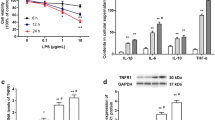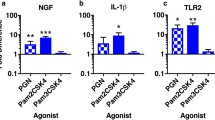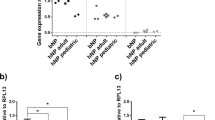Abstract
Steroid applications are able to repress inflammatory activity in various conditions, including herniation of the nucleus pulposus (HNP), by inhibiting tumour necrosis factor (TNF)-α, but the effects of long-term use are unknown. Here, we investigated the effect of dexamethasone (DEXA) on TNF-α-stimulated intervertebral disc cells by monitoring the expression and localization of NF-κB in the cytoplasm and nucleus. Cultured human intervertebral disc cells were left untreated or treated with only TNF-α, only DEXA, or with TNF-α and DEXA simultaneously. Cytoplasmic and nuclear proteins were extracted and Western blotted after 10 min, 1 or 2 h, to evaluate the expression of p50, p65, p52, and p100 (components of NF-κB). Immunofluorescence analysis was used to determine the subcellular localization of the proteins at 1 h. DEXA had limited effects on NF-κB expression in TNF-α-stimulated disc cells within the first 10 min. At 1 h, DEXA prevented the TNF-α-stimulated translocation of p50, p52, and p65. After 2 h, DEXA reduced the nuclear expression of p50, p65, and p52. Thus, DEXA resulted in delayed expression of NF-κB components and inhibited the translocation of p50, p52, and p65 to the nucleus, which would prevent expression of the corresponding genes. Therefore, following stimulation with TNF-α, transcriptional regulation of NF-κB in disc cells is mainly mediated via the classical pathway, but also to some extent via the alternative pathway. Hence, blockade of sub-acute inflammatory changes in HNP can be achieved by early injection of steroids, whereas long-term injection of a steroid may initiate NF-κB autophosphorylation.






Similar content being viewed by others
References
Ohba T, Haro H, Ando T, Wako M, Suenaga F, Aso Y, Koyama K, Hamada Y, Nakao A (2009) TNF-alpha-induced NF-kappaB signaling reverses age-related declines in VEGF induction and angiogenic activity in intervertebral disc tissues. J Orthop Res 27:229–235
Kjell O, Rolf S, Odd-Geir B (2002) Pathogenesis of sciatic pain: a study of spontaneous behavior in rats exposed to experimental disc herniation. Spine 27:1312–1317
Onda A, Yabuki S, Iwabuchi M, Anzai H, Olmarker K, Kikuchi S (2004) Lumbar sympathectomy increases blood flow in a dog model of chronic cauda equina compression. J Spinal Disord Tech 17:522–525
McLain RF, Kapural L, Mekhail NA (2005) Epidural steroid therapy for back and leg pain: mechanisms of action and efficacy. Spine J 5:191–201
Arend WP, Dayer JM (1995) Inhibition of the production and effects of interleukin-1 and tumor necrosis factor alpha in rheumatoid arthritis. Arthritis Rheum 38:151–160
Arenzana-Seisdedos F, Thompson J, Rodriguez MS, Bachelerie F, Thomas D, Hay RT (1995) Inducible nuclear expression of newly synthesized I kappa B alpha negatively regulates DNA-binding and transcriptional activities of NF-kappa B. Mol Cell Biol 15:2689–2696
Li H, Lin X (2008) Positive and negative signaling components involved in TNFalpha-induced NF-kappaB activation. Cytokine 41:1–8
Ghosh S, Hayden MS (2008) New regulators of NF-kappaB in inflammation. Nat Rev Immunol 8:837–848
Li Q, Verma IM (2002) NF-kappaB regulation in the immune system. Nat Rev Immunol 2:725–734
Xiao G, Rabson AB, Young W, Qing G, Qu Z (2006) Alternative pathways of NF-kappaB activation: a double-edged sword in health and disease. Cytokine Growth Factor Rev 17:281–293
Bonizzi G, Karin M (2004) The two NF-kappaB activation pathways and their role in innate and adaptive immunity. Trends Immunol 25:280–288
Wang F, Wu XT, Zhuang SY, Wang YT, Hong X, Zhu L, Bao JP (2011) Ex vivo observation of human nucleus pulposus chondrocytes isolated from degenerated intervertebral discs. Asian Spine J 5:73–81
Raghavendra V, Rutkowski MD, DeLeo JA (2002) The role of spinal neuroimmune activation in morphine tolerance/hyperalgesia in neuropathic and sham-operated rats. J Neurosci 22:9980–9989
Ma W, Eisenach JC (2003) Intraplantar injection of a cyclooxygenase inhibitor ketorolac reduces immunoreactivities of substance P, calcitonin gene-related peptide, and dynorphin in the dorsal horn of rats with nerve injury or inflammation. Neuroscience 121:681–690
Sen R, Baltimore D (1986) Multiple nuclear factors interact with the immunoglobulin enhancer sequences. Cell 46:705–716
Karin M, Cao Y, Greten FR, Li ZW (2002) NF-kappaB in cancer: from innocent bystander to major culprit. Nat Rev Cancer 2:301–310
Hayden MS, Ghosh S (2004) Signaling to NF-kappaB. Genes Dev 18:2195–2224
Hayden MS, Ghosh S (2008) Shared principles in NF-kappaB signaling. Cell 132:344–362
Leeman JR, Gilmore TD (2008) Alternative splicing in the NF-κB signaling pathway. Gene 423:97–107
Poveda L, Hottiger M, Boos N, Wuertz K (2009) Peroxynitrite induces gene expression in intervertebral disc cells. Spine 34:1127–1133
Mogensen TH, Berg RS, Paludan SR, Østergaard L (2008) Mechanisms of dexamethasone-mediated inhibition of Toll-like receptor signaling induced by Neisseria meningitidis and Streptococcus pneumoniae. Infect Immun 76:189–197
Lavagno L, Gunella G, Bardelli C, Spina S, Fresu LG, Viano I, Brunelleschi S (2004) Anti-inflammatory drugs and tumor necrosis factor-alpha production from monocytes: role of transcription factor NF-kappa B and implication for rheumatoid arthritis therapy. Eur J Pharmacol 501:199–208
Wang Z, Kang JS, Li Y, Yuan ZX, Liu SS, Sun LK (2006) The effects of dexamethasone on rat brain cortical nuclear factor kappa B (NF-kappaB) in endotoxic shock. Toxicol Appl Pharmacol 214:263–269
Eberhardt W, Schulze M, Engels C, Klasmeier E, Pfeilschifter J (2002) Glucocorticoid-mediated suppression of cytokine-induced matrix metalloproteinase-9 expression in rat mesangial cells: involvement of nuclear factor-kappaB and Ets transcription factors. Mol Endocrinol 16:1752–1766
Hayden MS, West AP, Ghosh S (2006) SnapShot: NF-kappaB signaling pathways. Cell 127:1286–1287
Zhong H, May MJ, Jimi E, Ghosh S (2002) The phosphorylation status of nuclear NF-κB determines its association with CBP/p300 or HDAC-1. Mol Cell 9:625–636
Acknowledgments
This work was supported by The Catholic University of Korea Daejeon St. Mary’s Hospital, and a clinical research institute grant funded by The Catholic University of Korea Daejeon St. Mary’s Hospital.
Conflict of interest
The authors have no conflict of interest.
Author information
Authors and Affiliations
Corresponding author
Additional information
Meiling Quan and Sang-Eun Park equally contributed to the first authorship.
Rights and permissions
About this article
Cite this article
Quan, M., Park, SE., Lin, Z. et al. Steroid treatment can inhibit nuclear localization of members of the NF-κB pathway in human disc cells stimulated with TNF-α. Eur J Orthop Surg Traumatol 25 (Suppl 1), 43–51 (2015). https://doi.org/10.1007/s00590-014-1499-8
Received:
Accepted:
Published:
Issue Date:
DOI: https://doi.org/10.1007/s00590-014-1499-8




